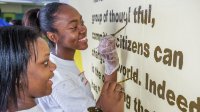Developing a Robust Community Engagement Program
A look at three key considerations in designing the most appropriate service program for your school.
Your content has been saved!
Go to My Saved Content.Community service is often used as a catch-all phrase for activities that, in reality, are quite different with regard to student involvement, community impact, and desired learning outcomes. For example, devoting a Saturday morning to cleaning up a local state beach might be a great volunteering or community service activity. On the other hand, an environmental science course with structured, recurring trips to state beaches where classroom learning contributed directly to the cleanup activities, and the cleanup activities contributed directly to the classroom learning, would be an example of service learning.
Distinguishing between different styles of community engagement allows you to clarify expectations, define learning outcomes, and incorporate best practices.
Step One: Choose the Right Kind of Service
Andrew Furco, a scholar at the University of California, Berkeley, distinguished between different types of community service based on the degree to which a given service activity focuses on service or learning, and the degree to which the primary beneficiary is the service recipient or the student.
Volunteerism and community service: Furco defined volunteerism as “the engagement of students in activities where the primary emphasis is on the service being provided and the primary intended beneficiary is clearly the service recipient." For most schools, these are the most common service activities because they are simple to organize, are easy to track, and require little to no class time before and after the activity. These are the classic food, clothing, or toy drives; park cleanups; and visits to homeless shelters that one often encounters in middle and high schools.
Internships and field studies: These are activities in which the student is the primary intended beneficiary and the purpose of the program is to enable student learning and/or vocational development via the acquisition of important skills or experience, Furco said. Some examples are afternoon internships with a veterinary clinic, mini-terms focused on environmental science field studies, or senior projects focusing on social services offered to immigrant families.
Service learning: Service learning differs from other experiential learning models because of its intention to equally benefit both the service provider and the recipient as well as to ensure equal focus on both service and learning. For example, students in an environmental science course may learn about composting, soil chemistry, and food waste in class and use that knowledge to create a cafeteria composting program on campus. In this sort of arrangement, the service activity enhances student learning, and student learning enhances the service provided. As Furco concluded, “It is this balance that distinguishes service learning from all other experiential learning programs.”
Step Two: What Kind of Program Is Right for Your School?
Addressing the following two questions can help you be more deliberate in selecting the type of program most suited to your student body and school mission.
Why do you have this program? What are your desired learning outcomes? If you are seeking to provide introductory opportunities intended to expose students to the importance of service, or if your school requires service hour quotas by grade, consider starting on the volunteerism side of the service spectrum. Some of the activities described above are simple ways to expose large portions of the student body to activities.
What are your school’s strengths and limitations? Perhaps you are limited to infrequent, extracurricular, and/or weekend service opportunities due to school or sports scheduling. In this case, consider starting with episodic yet meaningful volunteer opportunities. If you have a robust experiential learning program, consider developing structured service learning opportunities or fully integrating service-related internships and field studies into your experiential learning blocks.
Step Three: Implement Best Practices
Once you understand the types of community service offerings your school would like to implement, you can learn from others and work to incorporate lessons learned and best practices into your program.
Leverage your community: Community engagement makes service learning more meaningful. Prioritize partnerships with faculty/staff, parental networks, and alumni networks whenever possible. For example, our school has connections with the local forest association, enabling students to organize back-country trail maintenance outings as recurring service opportunities.
Create student ownership: Students often find service projects more meaningful when they’ve played a role in selecting them. This “voice and choice” and “student agency” can be fully autonomous with older students or somewhat controlled with younger ones. For example, a science teacher could guide students to select an end-of-year class service learning project focusing on sustainability by challenging them to research and select from a list of preapproved topics such as cafeteria composting, parking lot solar lighting, or school water conservation.
Enduring, not episodic: Commitments build character. As a result, we as educators have a duty to provide students with opportunities to commit themselves to organizations, causes, people, or places as often as possible. Consider committing certain courses or grades to specific organizations, issues, themes, or skills with recurring opportunities to stay involved. These sorts of enduring relationships allow students to dive deeper into delicate, complex challenges and can help avoid the phenomenon of “saviorism,” or the notion that we are temporarily entering communities different than our own to help “rescue” people.
Think global, act local: Local decisions often have global consequences. Challenge yourself and your students to understand the reciprocal, globalized nature of individual actions and habits and their second- and third-order effects. For example, a field study focusing on water conservation efforts in California could easily be linked to complex global events, such as the ongoing droughts and desertification in the Sahel region of Africa, as well as simple individual actions, such as turning off the faucet when brushing one’s teeth.
Martin Luther King Jr. once said, “Life’s most persistent and urgent question is: ‘What are you doing for others?’” Students learn how to respond to this question through participation in sustained community service opportunities.
